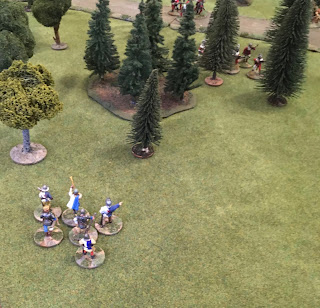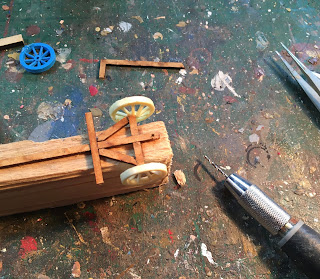The forage token markers in the picture above (the pile of boxes and the donkey) are two of the four in the scenario. They had differing values. When a player picked up a forage token by I revealed the value of a forage token to him only. I'd prepared playing cards of the relevant values as a way of randomly selecting them.
The table was symmetrical this time. North is at the top of the map.
The central farm area was deemed to be Rough Going and to provide cover from shooting. The big brown rectangles are ploughed fields (also Rough Going) and there's a small wood on the northern edge of the field. The blue dots represent the four forage tokens.
I gave each player an entry point at a corner of the table. Northwest was Albert Saysions-de-Dôge (Burgundian, Gus). Southwest was Gerhardt-Heinrich von Schimmel (Burgundian, Mark). Northeast was Gustav Sneffl (Swiss, Andy) and south east was Beat Züsli (Swiss, John).
I allocated about thirty points a-side and allowed the players to split the forces between them. Although the table was symmetrical, I wanted the tactical problems between the two sides to be different. For this reason I gave the Burgundians to units of mounted men-at-arms. I declared these to be Fastidious; a special house-rule that allowed them to ignore the Bauer for the purposes of Wild Charges but also meant that they would play no part in the actual carrying of forage tokens!
I'd assumed the Burgundian players would take one unit of Mounted Men-at-Arms each so as to share out the inconvenience but instead they chose to give both of them to Gus.
Somewhat unusually, Gus managed to get all of his forces (Men-at-Arms and longbows) onto the table on turn one! There was much rejoicing in the Burgundian camp.
Andy's Swiss mounted crossbows made use of their 12" move distance to hare towards the east side of the farm.
With a couple of shots and then a short, sharp melee, they drove off the Bauer guarding that side of the complex.
Meanwhile, two groups of Bidowers (John's Swiss in red and white, foreground below) and Mark's Italian mercenaries were also converging on the east end of the farm.
Soon the mounted crossbows were making heir way east with the captured sheep (who turned out to be worth four forage points).
Mark's Italian crossbowmen got the better of John's Swiss bidowers and were soon making off with the barrel (also worth four points).
They were, however, chased by John's Swiss and Irish mercenaries.
In the picture above we can also see the western units of Bauer cowering back from the accurate arrows of Gus's Burgundian longbowmen.
At this point, my slapdash efforts at photo-journalism let us down. I got no pictures of Albert Sayssions-de-Dôge leading his Burgundian men-at-arms into the teeth of the Swiss attack.
Surrounded by enemy troops including very menacing unit of halberdiers (Fierce Foot) lining the edge of the woods, Albert three times challenged Sneffl to a duel and was three times refused. There was some delay to the arrival of on of the Swiss pike units as they debated whether this was acceptable behaviour (a couple of failed courage tests as a result of the failure to accept the challenges).
We played another House Rule, this time that a Men-at-Arms unit led by a Leader whose Challenge was refused could subsequently activate, ignoring the Wild Charge rule that turn.
Eventually there was a melee when the Swiss pikes advanced on Albert's men-at-arms. Both sides took serious casualties but of course a six-model mounted unit can absorb less damage before it becomes degraded in its fighting power.
Finally, Albert's unit could no longer put off the Wild Charge that had been brewing. With von Schimmel out of Challenge range, Albert charged one of Beat Züsli's skirmisher units that had been trying to sneak round the farmhouse to steal the penultimate forage token. Fighting in Rough Ground, Albert was unhorsed and dashed to the ground!
In the meantime, the second unit of Italian mercenary crossbowmen had made off with the third forage token (the six pointer!) putting Mark well in the lead.
A subsequent charge by the other Burgundian Men-at-arms unit did wipe out the Swiss skirmishers allowing Gus's longbowmen to grab the remaining token. Sadly for Gus this was had only a two point value.
The game then degenerated into a chase in which the Burgundians tried to escort off the last forage token using their last two units; Mark's pikes and Gus's longbowmen. After much cursing over failed activation rolls this was eventually achieved in a tense finish.
At the end of the game Gus decided that this time he would roll on the heroic escape table from The Pikeman's Lament (which we're using in this "campaign"). The result was that although initially believed dead, Albert Saysions-de-Dôge escaped to return to the Burgundian camp with a thrilling tale and an impressive scar.
At the end of the game the distribution of Glory was as follows:
Gerhardt-Heinrich von Schimmel* gained ten points of Glory for a running total of 10
Albert Saysions-de-Dôge gained two points, less one for a failed Boast, plus one for his heroic escape for a running total of 2. In fact make that 3; I'm going to use umpire's privilege to award an additional point for conspicuous bravery.
Beat Züsli failed to add to his Glory. His running total remains at 10.
And finally, Gustav Sneffl added four points of Glory to lead with 12 despite turning down a grand total of three challenges to single combat and surviving a fourth! I have feeling the rules don't allow such multiple challenges but what the hell, it was fun!
* Note that in previous write-ups von Schimmel has been called Heinrich but throughout this game he was definitely referred to as Gerhardt so I've decided he must be Gerhardt-Heinrich.































